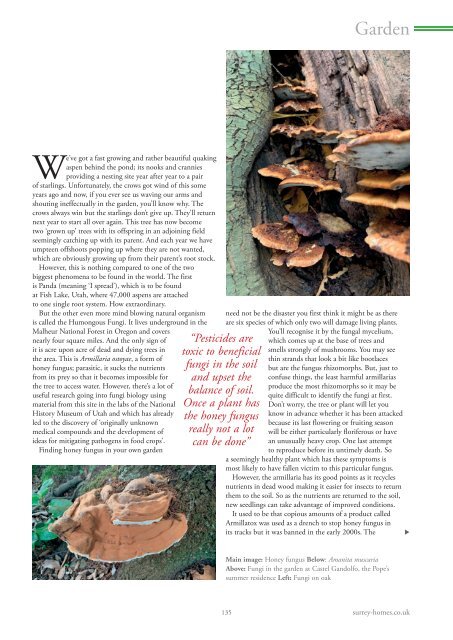Surrey Homes | SH61 | November 2019 | Gift supplement inside
The lifestyle magazine for Surrey - Inspirational Interiors, Fabulous Fashion, Delicious Dishes
The lifestyle magazine for Surrey - Inspirational Interiors, Fabulous Fashion, Delicious Dishes
You also want an ePaper? Increase the reach of your titles
YUMPU automatically turns print PDFs into web optimized ePapers that Google loves.
Garden<br />
We’ve got a fast growing and rather beautiful quaking<br />
aspen behind the pond; its nooks and crannies<br />
providing a nesting site year after year to a pair<br />
of starlings. Unfortunately, the crows got wind of this some<br />
years ago and now, if you ever see us waving our arms and<br />
shouting ineffectually in the garden, you’ll know why. The<br />
crows always win but the starlings don’t give up. They’ll return<br />
next year to start all over again. This tree has now become<br />
two ‘grown up’ trees with its offspring in an adjoining field<br />
seemingly catching up with its parent. And each year we have<br />
umpteen offshoots popping up where they are not wanted,<br />
which are obviously growing up from their parent’s root stock.<br />
However, this is nothing compared to one of the two<br />
biggest phenomena to be found in the world. The first<br />
is Panda (meaning ‘I spread’), which is to be found<br />
at Fish Lake, Utah, where 47,000 aspens are attached<br />
to one single root system. How extraordinary.<br />
But the other even more mind blowing natural organism<br />
is called the Humongous Fungi. It lives underground in the<br />
Malheur National Forest in Oregon and covers<br />
nearly four square miles. And the only sign of<br />
it is acre upon acre of dead and dying trees in<br />
the area. This is Armillaria ostoyae, a form of<br />
honey fungus; parasitic, it sucks the nutrients<br />
from its prey so that it becomes impossible for<br />
the tree to access water. However, there’s a lot of<br />
useful research going into fungi biology using<br />
material from this site in the labs of the National<br />
History Museum of Utah and which has already<br />
led to the discovery of ‘originally unknown<br />
medical compounds and the development of<br />
ideas for mitigating pathogens in food crops’.<br />
Finding honey fungus in your own garden<br />
“Pesticides are<br />
toxic to beneficial<br />
fungi in the soil<br />
and upset the<br />
balance of soil.<br />
Once a plant has<br />
the honey fungus<br />
really not a lot<br />
can be done”<br />
need not be the disaster you first think it might be as there<br />
are six species of which only two will damage living plants.<br />
You’ll recognise it by the fungal mycelium,<br />
which comes up at the base of trees and<br />
smells strongly of mushrooms. You may see<br />
thin strands that look a bit like bootlaces<br />
but are the fungus rhizomorphs. But, just to<br />
confuse things, the least harmful armillarias<br />
produce the most rhizomorphs so it may be<br />
quite difficult to identify the fungi at first.<br />
Don’t worry, the tree or plant will let you<br />
know in advance whether it has been attacked<br />
because its last flowering or fruiting season<br />
will be either particularly floriferous or have<br />
an unusually heavy crop. One last attempt<br />
to reproduce before its untimely death. So<br />
a seemingly healthy plant which has these symptoms is<br />
most likely to have fallen victim to this particular fungus.<br />
However, the armillaria has its good points as it recycles<br />
nutrients in dead wood making it easier for insects to return<br />
them to the soil. So as the nutrients are returned to the soil,<br />
new seedlings can take advantage of improved conditions.<br />
It used to be that copious amounts of a product called<br />
Armillatox was used as a drench to stop honey fungus in<br />
its tracks but it was banned in the early 2000s. The<br />
<br />
Main image: Honey fungus Below: Amanita muscaria<br />
Above: Fungi in the garden at Castel Gandolfo, the Pope’s<br />
summer residence Left: Fungi on oak<br />
135 surrey-homes.co.uk


















